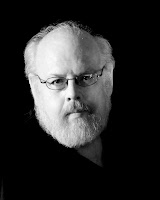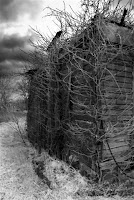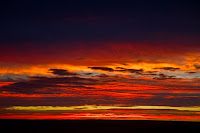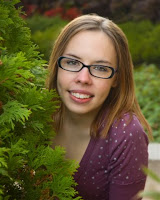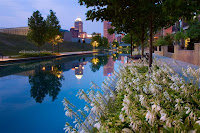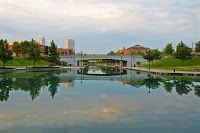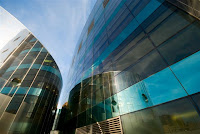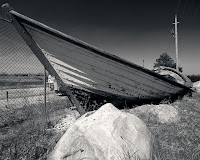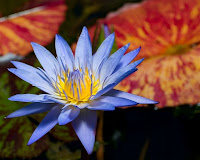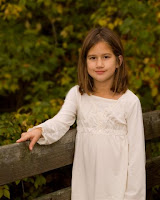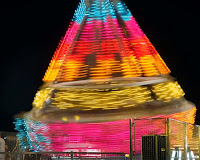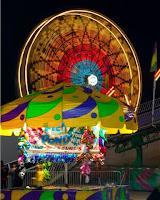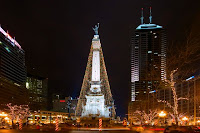 Above: The downtown skyline, looking east, as seen from an upper-level outdoor dining area adjacent to the Indiana State Museum.
Above: The downtown skyline, looking east, as seen from an upper-level outdoor dining area adjacent to the Indiana State Museum. As promised, I returned to the Downtown Canal soon -- on Sunday, as a matter of fact. I hadn't realized until then how much of a people magnet that place is on weekends -- strollers, groups, families, roller-bladers, joggers, bikers and kayak and paddleboat riders.
 Above: The canal, near its center point, with the water color reflecting its partial illumination and partial shade.
Above: The canal, near its center point, with the water color reflecting its partial illumination and partial shade.I spent about three hours on just one segments of the canal the center and a bit south of there up to the tennis center. I know there's more to it on each end, but perhaps another day. Still, I shot more than 200 frames; I can't imagine how many more frames are waiting for me on the subsequent visits!
 Above: A look north from one of the footbridges, as two people sharing a paddleboat head toward a city street spanning the canal.
Above: A look north from one of the footbridges, as two people sharing a paddleboat head toward a city street spanning the canal. I have several "favorites," including shots of the downtown skyline from the upper-level outdoor restaurant (not open that day) adjacent to the Indiana State Museum. It's a seen I've seen quite a bit in images uploaded to the CaptureIndy site that I've mentioned here before. I used a circular polarizer for all my shots, hoping to cultivate some rich color in my skies and to deflect glare on the watertop.
 Above: The glass facade of the backside of the Indiana State Museum. The reflection, at the very bottom, nicely captured some pedestrians who would have just been out of the camera's frame.
Above: The glass facade of the backside of the Indiana State Museum. The reflection, at the very bottom, nicely captured some pedestrians who would have just been out of the camera's frame.The former objective was fulfilled; I got some very nice, rich blues with very little boosting necessary in post-processing. As for the latter, I found out that as long as I was far enough away, water shots were OK. But a polarizer -- perhaps because it also layered with my UV filter that I keep on the lenses at all times -- distorts close shots of the water beyond what I had ever imagined. The colors were psychedelic ... rendering many of my otherwise nice duck shots to the sideline.
 Above: From a prone position under one of the street bridges, I grabbed this water-level shot of a couple in one of the paddleboats heading south.
Above: From a prone position under one of the street bridges, I grabbed this water-level shot of a couple in one of the paddleboats heading south.On the way home, I saw some fantastic cloud patterns, so I grabbed a few frames of those, too. Several hovered in the eastern sky above a NAPA car parts store at West and McCarty streets, and the others were in the western sky, the sun hiding behind them to create a celestial spectacle.
 Above: The canal even attracts its share of street musicians, apparently. This guitarist was seated at the bend in the area of the Indiana State Museum.
Above: The canal even attracts its share of street musicians, apparently. This guitarist was seated at the bend in the area of the Indiana State Museum.  Above: I like to shoot photographs of other people taking group picture photographs. I grabbed this while I was still prone on the sidewalk under one of the bridges.
Above: I like to shoot photographs of other people taking group picture photographs. I grabbed this while I was still prone on the sidewalk under one of the bridges.  Above: One of the duck shots that actually turned out.
Above: One of the duck shots that actually turned out. Above: I wouldn't swear that any of these ducks was the same one I captured in the frame above, but this shot -- taken from a bridge overlooking the same bend and fountain where the street musician played -- proves that I wasn't the only one with a fascination for the water fowl creatures.
Above: I wouldn't swear that any of these ducks was the same one I captured in the frame above, but this shot -- taken from a bridge overlooking the same bend and fountain where the street musician played -- proves that I wasn't the only one with a fascination for the water fowl creatures.  Above: A juxtaposition encompassing depth of field that I reallyed liked. The light fixtured is in the foreground along one of the street bridges; the OneAmerica insurance is a few blocks away.
Above: A juxtaposition encompassing depth of field that I reallyed liked. The light fixtured is in the foreground along one of the street bridges; the OneAmerica insurance is a few blocks away.  Above: The steam clock stands outside the Indiana State Museum. This image gives you the best of "cloudlike" shapes -- the cloud reflection off the museum's glass facade, and the more vivid steam spewing from the top of the clock.
Above: The steam clock stands outside the Indiana State Museum. This image gives you the best of "cloudlike" shapes -- the cloud reflection off the museum's glass facade, and the more vivid steam spewing from the top of the clock.  Above: One of the shots of the eastern sky cloudscape, just above the NAPA auto parts store.
Above: One of the shots of the eastern sky cloudscape, just above the NAPA auto parts store.  Above: The western sky clouds, helping hide the sun on a late afternoon. I took this from Pleasant Run Parkway, just west of Meridian Street.
Above: The western sky clouds, helping hide the sun on a late afternoon. I took this from Pleasant Run Parkway, just west of Meridian Street.











